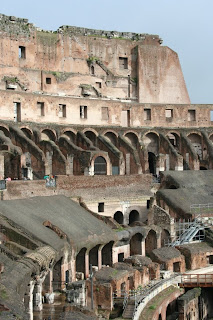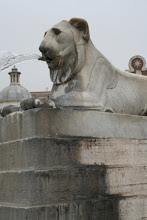
One of my constant companions here in Rome has been Henry Morton's A Traveller in Rome, written in 1957 and still an engaging and relevant read about this great city. With his gentle humour and historical references, this book has sat on my bedside table for a month now and there’s seldom a day when I haven’t referred to it as my definitive guide.
Of fascination are Morton’s references to the necropolis under the Vatican. At the time of his writing the excavations were not open to public view and had only been laid bare some seven years previous. Various popes had been reluctant to disturb the remains of the apostle St Peter, and it was only in 1939, under Pope Pius XII, that a decision was made to excavate the Vatican hill. The excavations took ten years to complete; at times the work was delicate and picks and shovels could not be used – the excavators worked using their hands.
Of fascination are Morton’s references to the necropolis under the Vatican. At the time of his writing the excavations were not open to public view and had only been laid bare some seven years previous. Various popes had been reluctant to disturb the remains of the apostle St Peter, and it was only in 1939, under Pope Pius XII, that a decision was made to excavate the Vatican hill. The excavations took ten years to complete; at times the work was delicate and picks and shovels could not be used – the excavators worked using their hands.
Morton's tour of the scavi was specially arranged, and his guide spent some time translating the inscriptions on the tombs. One of these, on the tomb of Flavius Agricola, gives some cheerful advice: 'Friends who read this, do my bidding. Mix the wine, drink deep, wreathed with flowers, and do not refuse pretty girls the sweets of love'.
The scavi (excavations) can now be viewed with written permission from the Vatican. Back in October, I emailed the Vatican seeking permission for Jim and I to visit. Within a couple of weeks I got a reply confirming our visit for 24th February.
On the appointed day and hour, we present ourselves to the Swiss Guard at the gate on the left colonnade and are admitted through to the official offices of the Vatican. We join a small group of 10 led by an English-speaking guide, and via the Excavation Office we descend some stairs and enter a narrow passage with a sealed door. Our guide slides this door open, and we climb through to the scavi.
It is very dry and warm 30 feet under St Peters. We stand at the end of a passage and look upon an ancient Roman street with crypts opening on both sides. As we begin to walk along the street, our guide tells us we were actually walking up the gentle slope of the Vatican hill, with our ultimate destination being the tomb of St Peter. The crypts we can see are frescoed in brilliant Pompeian reds, greens and blues and depict flowers, animals and fruits. We stop to look at a mosaic floor, showing subsidence over the 1800 years since it was laid. Above the crypts tablets in marble pay tribute to the dead, with invitation for the relatives and freedmen of the family to also inter remains in the family tombs. The paintings on the tombs are still fresh and vibrant.
Our guide tells us we are level with, and below, the left aisle of the basilica’s nave. The area of the exactions uncovered is about 200 feet long and contains 27 family tombs; tombs of wealthy middle-class Romans of the 1st and 2nd centuries AD. Further excavation is not possible without danger to the church above, particularly as the massive weight of Michelangos’s dome is supported by concrete footings some 15 feet wide.
As we continue forward, we hear how the Emperor Constantine built the early church of St Peter’s on the Vatican Hill purely to honour the bones of the Apostle below. We see the ancient altar built over the bones of St Peter and we cross in front, and then behind, the tomb seeing the columned structure that now holds the remains. To protect the bones from damage and theft, Constantine had erected a marble cube around the tomb and the bones are now housed in special airtight containers. Surprisingly, there are several of these containers holding some 70 or 80 bones of the Saint.
We finish our tour in a little chapel under the current basilica; through a hole in the roof we can see into the light of the current church above. Our guide leaves us at the frescoed ceiling of the first level below St Peters where some of the early, and latter-day popes are housed, and we pass the tomb of Pope John Paul II who died in 2005. Continuing up the stairs to the current basilica we spend some time admiring ‘modern’ St Peters before heading home along the Tiber.
The scavi (excavations) can now be viewed with written permission from the Vatican. Back in October, I emailed the Vatican seeking permission for Jim and I to visit. Within a couple of weeks I got a reply confirming our visit for 24th February.
On the appointed day and hour, we present ourselves to the Swiss Guard at the gate on the left colonnade and are admitted through to the official offices of the Vatican. We join a small group of 10 led by an English-speaking guide, and via the Excavation Office we descend some stairs and enter a narrow passage with a sealed door. Our guide slides this door open, and we climb through to the scavi.
It is very dry and warm 30 feet under St Peters. We stand at the end of a passage and look upon an ancient Roman street with crypts opening on both sides. As we begin to walk along the street, our guide tells us we were actually walking up the gentle slope of the Vatican hill, with our ultimate destination being the tomb of St Peter. The crypts we can see are frescoed in brilliant Pompeian reds, greens and blues and depict flowers, animals and fruits. We stop to look at a mosaic floor, showing subsidence over the 1800 years since it was laid. Above the crypts tablets in marble pay tribute to the dead, with invitation for the relatives and freedmen of the family to also inter remains in the family tombs. The paintings on the tombs are still fresh and vibrant.
Our guide tells us we are level with, and below, the left aisle of the basilica’s nave. The area of the exactions uncovered is about 200 feet long and contains 27 family tombs; tombs of wealthy middle-class Romans of the 1st and 2nd centuries AD. Further excavation is not possible without danger to the church above, particularly as the massive weight of Michelangos’s dome is supported by concrete footings some 15 feet wide.
As we continue forward, we hear how the Emperor Constantine built the early church of St Peter’s on the Vatican Hill purely to honour the bones of the Apostle below. We see the ancient altar built over the bones of St Peter and we cross in front, and then behind, the tomb seeing the columned structure that now holds the remains. To protect the bones from damage and theft, Constantine had erected a marble cube around the tomb and the bones are now housed in special airtight containers. Surprisingly, there are several of these containers holding some 70 or 80 bones of the Saint.
We finish our tour in a little chapel under the current basilica; through a hole in the roof we can see into the light of the current church above. Our guide leaves us at the frescoed ceiling of the first level below St Peters where some of the early, and latter-day popes are housed, and we pass the tomb of Pope John Paul II who died in 2005. Continuing up the stairs to the current basilica we spend some time admiring ‘modern’ St Peters before heading home along the Tiber.









 Rome is experiencing sunny blue skies at the moment – this is our third day of clear weather. These photos were taken yesterday from the top of the Capitoline Hill; in the first, and looking towards the west, you can see the dome of the church of San Andrea delle Valle (one of my near neighbours) and further on, the dome of St Peter’s.
Rome is experiencing sunny blue skies at the moment – this is our third day of clear weather. These photos were taken yesterday from the top of the Capitoline Hill; in the first, and looking towards the west, you can see the dome of the church of San Andrea delle Valle (one of my near neighbours) and further on, the dome of St Peter’s. 
















